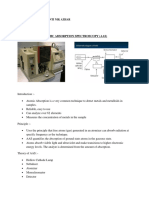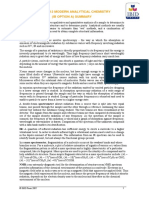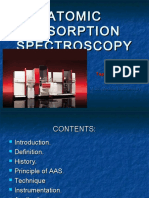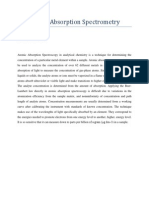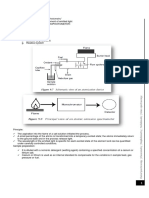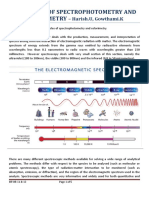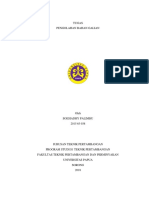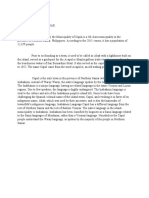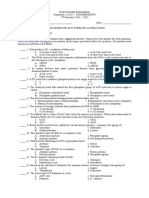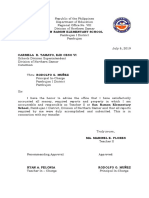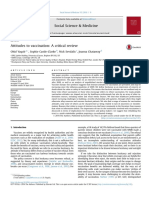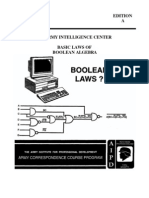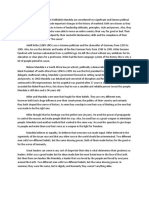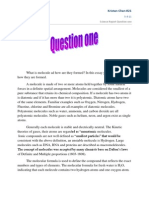0 ratings0% found this document useful (0 votes)
67 viewsAAS Written Report
AAS Written Report
Uploaded by
Inga Budadoy NaudadongAtomic absorption spectroscopy is a quantitative analytical technique used to determine the concentration of chemical elements in a sample. It works by measuring the absorption of light by ground state atoms in a vapor phase. The technique can analyze over 62 elements and is sensitive enough to measure parts per billion of a gram in a sample. The key components of an atomic absorption spectroscopy instrument are a hollow cathode lamp, nebulizer, monochromator, and detector. The history of atomic absorption spectroscopy began with the atomic theory proposed by John Dalton and spectroscopic analysis of elements by Bunsen and Kirchhoff. It is now commonly used for clinical and environmental analysis.
Copyright:
© All Rights Reserved
Available Formats
Download as DOCX, PDF, TXT or read online from Scribd
AAS Written Report
AAS Written Report
Uploaded by
Inga Budadoy Naudadong0 ratings0% found this document useful (0 votes)
67 views3 pagesAtomic absorption spectroscopy is a quantitative analytical technique used to determine the concentration of chemical elements in a sample. It works by measuring the absorption of light by ground state atoms in a vapor phase. The technique can analyze over 62 elements and is sensitive enough to measure parts per billion of a gram in a sample. The key components of an atomic absorption spectroscopy instrument are a hollow cathode lamp, nebulizer, monochromator, and detector. The history of atomic absorption spectroscopy began with the atomic theory proposed by John Dalton and spectroscopic analysis of elements by Bunsen and Kirchhoff. It is now commonly used for clinical and environmental analysis.
Original Title
AAS written report
Copyright
© © All Rights Reserved
Available Formats
DOCX, PDF, TXT or read online from Scribd
Share this document
Did you find this document useful?
Is this content inappropriate?
Atomic absorption spectroscopy is a quantitative analytical technique used to determine the concentration of chemical elements in a sample. It works by measuring the absorption of light by ground state atoms in a vapor phase. The technique can analyze over 62 elements and is sensitive enough to measure parts per billion of a gram in a sample. The key components of an atomic absorption spectroscopy instrument are a hollow cathode lamp, nebulizer, monochromator, and detector. The history of atomic absorption spectroscopy began with the atomic theory proposed by John Dalton and spectroscopic analysis of elements by Bunsen and Kirchhoff. It is now commonly used for clinical and environmental analysis.
Copyright:
© All Rights Reserved
Available Formats
Download as DOCX, PDF, TXT or read online from Scribd
Download as docx, pdf, or txt
0 ratings0% found this document useful (0 votes)
67 views3 pagesAAS Written Report
AAS Written Report
Uploaded by
Inga Budadoy NaudadongAtomic absorption spectroscopy is a quantitative analytical technique used to determine the concentration of chemical elements in a sample. It works by measuring the absorption of light by ground state atoms in a vapor phase. The technique can analyze over 62 elements and is sensitive enough to measure parts per billion of a gram in a sample. The key components of an atomic absorption spectroscopy instrument are a hollow cathode lamp, nebulizer, monochromator, and detector. The history of atomic absorption spectroscopy began with the atomic theory proposed by John Dalton and spectroscopic analysis of elements by Bunsen and Kirchhoff. It is now commonly used for clinical and environmental analysis.
Copyright:
© All Rights Reserved
Available Formats
Download as DOCX, PDF, TXT or read online from Scribd
Download as docx, pdf, or txt
You are on page 1of 3
WRITTEN REPORT
IN
TECHNICAL ANALYSIS
SUBMITTED BY:
JUDELYN JARITO
BS CHEMISTRY 4
SUBMITTED TO:
MA. LOURDES ALVAREZ, PhD.
ATOMIC ABSORPTION SPECTROSCOPY
INTRODUCTION
Atomic absorption measures the amount of light at the resonant wavelength
which is absorbed as it passes through in a cloud of atoms. As the number of atoms in
the light path increases, the amount of light absorbed increases in a predictable way.
The technique is used for determining the concentration of a particular element
(analyte) in a sample to be analyzed. Atomic absorption is so sensitive that it can
measure down to parts per billion of a gram in a sample.
OBJECTIVES:
1. To define what is Atomic Absorption Spectroscopy (AAS)
2. To know the history of AAS
3. To know the application of AAS
WHAT IS ATOMIC ABSORPTION SPECTROSCOPY?
Is a quantitative method of analysis that is applicable to many metals and a few
non-metals.
It also measures the concentration of metals in the sample.
It quantifies the absorption of ground state atoms in the gaseous state.
It can analyze over 62 elements.
INSTRUMENTATION OF ATOMIC ABSORBTION SPECTROSCOPY
HOLLOW CATHODE LAMP- a large voltage across anode & cathode causes
the inert gas to ionize & form a plasma.
NEBULISER- forms a mist or aerosol of the sample.
MONOCHROMATOR- used to select the specific wavelength of light which is
absorbed by the sample, and to exclude other wavelengths.
DETECTOR- the light selected by the monochromator is directed into a
photomultiplier tube, whose function is to convert the light signal into an electrical
signal proportional to the light intensity.
HISTORY OF ATOMIC ABSORPTION SPECTROSCOPY
Atomic theory began with JOHN DALTON in the 18th century when he proposed
the concept of atoms, that all atoms of an element are identical, and that atoms
of different elements can combine to form molecules.
ROBERT BUNSEN and GUSTAV KIRCHHOFF studied the sodium spectrum
and came to the conclusion that every element has its own unique spectrum that
can be used to identify elements in the vapor phase.
The first atomic absorption spectrometer was presented by ALAN WALSH and
co-workers in Melbourne in 1954.
APPLICATION OF ATOMIC ABSORBTION SPECTROSCOPY
CLINICAL ANALYSIS- analyzing metals in biological fluids such as blood and urine.
ENVIRONMENTAL ANALYSIS- monitoring our environment- e.g finding out the levels
of various elements in rivers, seawater, drinking water, air, petrol, and drinks.
You might also like
- Mass Spectrometry CompleteDocument155 pagesMass Spectrometry CompleteKamran AlamNo ratings yet
- Rutendo The Chiefs GranddaughterDocument35 pagesRutendo The Chiefs GranddaughterValerie Bekkah100% (8)
- Maimoona Saeed: Atomic Absorption SpectrometerDocument5 pagesMaimoona Saeed: Atomic Absorption SpectrometerUjala AsadNo ratings yet
- InTech-Atomic Absorption Spectrometry AasDocument13 pagesInTech-Atomic Absorption Spectrometry Aastaufany99No ratings yet
- Atomic Absorption SpectrosDocument16 pagesAtomic Absorption Spectrosjohnpaul varonaNo ratings yet
- Atomic Absorption SpectrosDocument4 pagesAtomic Absorption SpectrosAye Ei MonNo ratings yet
- Atomic Absorption SpectrometryDocument36 pagesAtomic Absorption SpectrometryZubair Kamboh100% (1)
- Atomic Spectroscopy: Absorption Spectroscopy: AAS Emission Spectroscopy: FES, Icp-Aes (Oes)Document19 pagesAtomic Spectroscopy: Absorption Spectroscopy: AAS Emission Spectroscopy: FES, Icp-Aes (Oes)shruti shahNo ratings yet
- Atomic Absorption Spectroscopy (Aas) : Nama: Nik Adibah Binti Nik Azhar NO. MATRIK: A155516Document4 pagesAtomic Absorption Spectroscopy (Aas) : Nama: Nik Adibah Binti Nik Azhar NO. MATRIK: A155516DidiAzharNo ratings yet
- Aas 190429140632Document23 pagesAas 190429140632anujaNo ratings yet
- Atomic Spectroscopy (Suneetha)Document28 pagesAtomic Spectroscopy (Suneetha)valterkNo ratings yet
- Makalah AAS NovA 300 BingDocument14 pagesMakalah AAS NovA 300 BingAhmad Fadil DjamilNo ratings yet
- Unit 10 Atomic Emission SpectrometryDocument26 pagesUnit 10 Atomic Emission SpectrometryVelpuri Venkatappaiah67% (3)
- Atomic Absorption SpectrosDocument6 pagesAtomic Absorption SpectrosShajith Ahamed ANo ratings yet
- Chemistry Student CD IBID PRESS CH 12 SummaryDocument5 pagesChemistry Student CD IBID PRESS CH 12 SummaryFranklin garryNo ratings yet
- Atomic Absorption SpectrosDocument30 pagesAtomic Absorption SpectrosRashed BiswasNo ratings yet
- Atomic Spectroscopy AnalysisDocument16 pagesAtomic Spectroscopy AnalysisMiftahul JannahNo ratings yet
- Aas Introduction 2022Document6 pagesAas Introduction 2022Korir DennisNo ratings yet
- AAS ReportDocument7 pagesAAS ReportDaisy NoveloNo ratings yet
- Determination of Heavy Metal Concentration by Atomic Absorption SpectrosDocument2 pagesDetermination of Heavy Metal Concentration by Atomic Absorption SpectrosNandhini D PNo ratings yet
- Atomic SpectrosDocument23 pagesAtomic SpectrosJean Kimberly AgnoNo ratings yet
- Neutron Activation Analysis (INAA and RNAA)Document4 pagesNeutron Activation Analysis (INAA and RNAA)Marco Antonio Enriquez QuirogaNo ratings yet
- Atomic Mass SpectrosDocument40 pagesAtomic Mass Spectrosjohnpaul varonaNo ratings yet
- Civil Engineering Workshop - Environmental Engineering Lab: 1. Total Organic Carbon (Toc) AnalyzerDocument3 pagesCivil Engineering Workshop - Environmental Engineering Lab: 1. Total Organic Carbon (Toc) Analyzersaikumar yellankiNo ratings yet
- Uv VisDocument4 pagesUv VisohoreyNo ratings yet
- Atomic Absorption SpectrometryDocument6 pagesAtomic Absorption Spectrometryifwat92No ratings yet
- Final AasDocument5 pagesFinal AasTanvir FahimNo ratings yet
- Final Optical Atomic Absorption SpectrometryDocument7 pagesFinal Optical Atomic Absorption SpectrometryferngetapeNo ratings yet
- Mass SpectrometryDocument30 pagesMass Spectrometryfatema100% (1)
- Aas NotesDocument10 pagesAas Notesp.ishaanpawarNo ratings yet
- AtomicDocument3 pagesAtomicRashidNo ratings yet
- Smita S. Mandal (Chemistry)Document19 pagesSmita S. Mandal (Chemistry)cytrfNo ratings yet
- Atomic Absorption SpectrometryDocument9 pagesAtomic Absorption SpectrometryRisnaNo ratings yet
- NAME: Mahnoor Kamran Roll Number: 22-80052: Submitted To: DR - Laiba ArshadDocument29 pagesNAME: Mahnoor Kamran Roll Number: 22-80052: Submitted To: DR - Laiba Arshadtayyab malikNo ratings yet
- L3.5 - EXTENDED SpectrosDocument14 pagesL3.5 - EXTENDED SpectrosarounasamuelsNo ratings yet
- Introduction To SpectrosDocument24 pagesIntroduction To SpectrosPIRZADA TALHA ISMAIL100% (1)
- Atomic Absorption Spectroscopy Written ReportDocument7 pagesAtomic Absorption Spectroscopy Written ReportMAYRELL PUN-ANNo ratings yet
- Spectroscopic Techniques by AwaisDocument58 pagesSpectroscopic Techniques by Awaishiraqueen249No ratings yet
- What Is Atomic Absorption Spectroscopy?: Atomization System, The Monochromator and The Detection System (Figure 1)Document3 pagesWhat Is Atomic Absorption Spectroscopy?: Atomization System, The Monochromator and The Detection System (Figure 1)Belal FatahNo ratings yet
- Atomic Emission SpectrosDocument14 pagesAtomic Emission SpectrosGjelo CachoNo ratings yet
- Hacettepe University Department of Chemical Engineering KMÜ 359 Instrumental Analysis Laboratories Experiment 5 Atomic Absorption SpectrosDocument13 pagesHacettepe University Department of Chemical Engineering KMÜ 359 Instrumental Analysis Laboratories Experiment 5 Atomic Absorption SpectrosGamze IdeNo ratings yet
- Assignment 1 Atomic Absorption SpectroscDocument22 pagesAssignment 1 Atomic Absorption Spectroscpakpolitics206No ratings yet
- Atomic Absorption SpectrosDocument62 pagesAtomic Absorption SpectrosJamal HamadNo ratings yet
- Afs (22 PCH 075)Document22 pagesAfs (22 PCH 075)taskinsaiyed082No ratings yet
- Spectro 6241 Et 6241 Et EtDocument15 pagesSpectro 6241 Et 6241 Et Etanshuman0001No ratings yet
- Unit 7 Flame PhotometryDocument32 pagesUnit 7 Flame PhotometryRia Agnez100% (8)
- Aulia Rahmah Triastanti 4C (kimorII)Document8 pagesAulia Rahmah Triastanti 4C (kimorII)AuliaRahmahTriastantiIINo ratings yet
- Fluorometry NotesDocument5 pagesFluorometry NotesHayna RoseNo ratings yet
- Spectrophotometry and ColorimetryDocument5 pagesSpectrophotometry and ColorimetryHarish.UNo ratings yet
- Mass SpectrosDocument72 pagesMass SpectrosUnknownuser YetNo ratings yet
- Atomic Emission Spectroscopy LectureDocument17 pagesAtomic Emission Spectroscopy LectureTanvir PharmNo ratings yet
- Chapter-9 Analytical Techniques SPJDocument13 pagesChapter-9 Analytical Techniques SPJAvesh pandeyNo ratings yet
- Magazine Anachem 1Document10 pagesMagazine Anachem 1Myca DelimaNo ratings yet
- tmp3588122518401173628-printDocument25 pagestmp3588122518401173628-printjosephusjohn009No ratings yet
- Tugas 3 PBGDocument8 pagesTugas 3 PBGSoesiadhy PalimbuNo ratings yet
- - محمد علاء عزيز (B) Document5 pages- محمد علاء عزيز (B) hhjjrr22331No ratings yet
- Laser Metrology in Fluid Mechanics: Granulometry, Temperature and Concentration MeasurementsFrom EverandLaser Metrology in Fluid Mechanics: Granulometry, Temperature and Concentration MeasurementsNo ratings yet
- Introduction to Voltammetric Analysis: Theory and PracticeFrom EverandIntroduction to Voltammetric Analysis: Theory and PracticeNo ratings yet
- Handbook of Fluorescent Gems and Minerals - An Exposition and Catalog of the Fluorescent and Phosphorescent Gems and Minerals, Including the Use of Ultraviolet Light in the Earth SciencesFrom EverandHandbook of Fluorescent Gems and Minerals - An Exposition and Catalog of the Fluorescent and Phosphorescent Gems and Minerals, Including the Use of Ultraviolet Light in the Earth SciencesNo ratings yet
- Capul Northern SamarDocument6 pagesCapul Northern SamarInga Budadoy NaudadongNo ratings yet
- Capul Northern SamarDocument6 pagesCapul Northern SamarInga Budadoy NaudadongNo ratings yet
- University of Eastern PhilippinesDocument1 pageUniversity of Eastern PhilippinesInga Budadoy NaudadongNo ratings yet
- Liquidation Report: ParticularsDocument15 pagesLiquidation Report: ParticularsInga Budadoy NaudadongNo ratings yet
- Monitoring, Evaluation and Adjustment (Mea) TemplateDocument20 pagesMonitoring, Evaluation and Adjustment (Mea) TemplateInga Budadoy NaudadongNo ratings yet
- Graphic Organizer Ge 4 Reading in Philippine History Graphic Organizer Ge 4 Reading in Philippine HistoryDocument10 pagesGraphic Organizer Ge 4 Reading in Philippine History Graphic Organizer Ge 4 Reading in Philippine HistoryInga Budadoy NaudadongNo ratings yet
- SF 4, 2018 OK San MiguelDocument18 pagesSF 4, 2018 OK San MiguelInga Budadoy NaudadongNo ratings yet
- Porofiling of Teachers of All SubjectsDocument2 pagesPorofiling of Teachers of All SubjectsInga Budadoy Naudadong100% (1)
- 3rd Quarter MEA DISTRICTDocument5 pages3rd Quarter MEA DISTRICTInga Budadoy NaudadongNo ratings yet
- Monitoring, Evaluation and Adjustment (Mea) TemplateDocument5 pagesMonitoring, Evaluation and Adjustment (Mea) TemplateInga Budadoy NaudadongNo ratings yet
- Deworming Form Grade 3 2019 To 2020Document3 pagesDeworming Form Grade 3 2019 To 2020Inga Budadoy NaudadongNo ratings yet
- Biochemistry: A Guide Notes and Workbook inDocument1 pageBiochemistry: A Guide Notes and Workbook inInga Budadoy NaudadongNo ratings yet
- Table of Specification (TOS) : San Ramon Elementary SchoolDocument2 pagesTable of Specification (TOS) : San Ramon Elementary SchoolInga Budadoy NaudadongNo ratings yet
- Biological Science DepartmentDocument8 pagesBiological Science DepartmentInga Budadoy NaudadongNo ratings yet
- A. Phosphoric Anhydride Bond B. Phosphate Peptide BondDocument5 pagesA. Phosphoric Anhydride Bond B. Phosphate Peptide BondInga Budadoy NaudadongNo ratings yet
- Clearance For TransferDocument2 pagesClearance For TransferInga Budadoy NaudadongNo ratings yet
- Republic of The Philippines: Good Luck!!Document8 pagesRepublic of The Philippines: Good Luck!!Inga Budadoy NaudadongNo ratings yet
- Long Term Project 1Document3 pagesLong Term Project 1Junrey Tubac TubioNo ratings yet
- Conducting A Water QualityDocument10 pagesConducting A Water QualityPrashansa ShresthaNo ratings yet
- Contra Ponto PDFDocument72 pagesContra Ponto PDFMARCO.S.X7952No ratings yet
- Attitudes Toward VaccinationDocument11 pagesAttitudes Toward VaccinationNadineAlmeidaNo ratings yet
- Hubungan Kekuatan Otot Punggung Dengan Keluhan Nyeri Punggung Pada Porter Di Stasiun Tawang SemarangDocument9 pagesHubungan Kekuatan Otot Punggung Dengan Keluhan Nyeri Punggung Pada Porter Di Stasiun Tawang SemarangAndi SulvanNo ratings yet
- Test Wifi Hotspot-Word ListDocument4 pagesTest Wifi Hotspot-Word ListM TauhidNo ratings yet
- IT0344 Basic Laws of Boolean AlgebraDocument42 pagesIT0344 Basic Laws of Boolean AlgebraBenjamin MartinNo ratings yet
- Adolf Hitler Nelson MandelaDocument1 pageAdolf Hitler Nelson MandelaRochelle ParafinaNo ratings yet
- Chapter 9 Responsibility Accounting - NotesDocument2 pagesChapter 9 Responsibility Accounting - NotesZeena Joy Caser SantiagoNo ratings yet
- 4.6 Teacher Training Certificate Course in YogaDocument11 pages4.6 Teacher Training Certificate Course in Yogasafwan kalshekarNo ratings yet
- Carrier Oils Chart PDFDocument4 pagesCarrier Oils Chart PDFFanfare FNo ratings yet
- FontsDocument4 pagesFonts4palleNo ratings yet
- (Paul Hawken, Amory Lovins, L. Hunter Lovins) Natu (B-Ok - Xyz) Part6Document1 page(Paul Hawken, Amory Lovins, L. Hunter Lovins) Natu (B-Ok - Xyz) Part6asmuviqNo ratings yet
- Sample: Married: Affidavit of ConfirmationDocument3 pagesSample: Married: Affidavit of ConfirmationGunnery SierraNo ratings yet
- Kle English Medium School: Jule Solapur Art & Craft Syllabus 2020-21 Grade - IDocument10 pagesKle English Medium School: Jule Solapur Art & Craft Syllabus 2020-21 Grade - IYash378 OPNo ratings yet
- Imam Ahmad Ibn Hanbal - The Champion of Islamic BeliefDocument3 pagesImam Ahmad Ibn Hanbal - The Champion of Islamic BeliefDhantel Rhesa PrawedhaNo ratings yet
- GST PPT June19Document65 pagesGST PPT June19yash bhushanNo ratings yet
- Effects of Hydrotherapy in Balance and Prevention of Falls Among Elderly WomenDocument60 pagesEffects of Hydrotherapy in Balance and Prevention of Falls Among Elderly WomenThermalBathsforActivNo ratings yet
- Math 4THDocument8 pagesMath 4THDarnell Raymundo CapurasNo ratings yet
- What Is Molecule Ad How Are They FormedDocument2 pagesWhat Is Molecule Ad How Are They FormedYing ChenNo ratings yet
- UntitledDocument286 pagesUntitledkrishna4351100% (1)
- FYBCom Compulsory English Sem-IDocument22 pagesFYBCom Compulsory English Sem-Ishivam kharivale 55100% (2)
- CezanneDocument36 pagesCezanneSanjay ContyNo ratings yet
- Sprite - An Innovative Product LaunchDocument23 pagesSprite - An Innovative Product LaunchdiyasiddhuNo ratings yet
- English 10 q1 Week 2Document10 pagesEnglish 10 q1 Week 2Ken AlapNo ratings yet
- Limitations of Z TheoryDocument6 pagesLimitations of Z TheoryAnand Verma100% (1)
- The Secret Cave of The HeartDocument19 pagesThe Secret Cave of The HeartkatburnerNo ratings yet
- Pathophysiology of Hypertension, Diabetes, Ubm, BPHDocument3 pagesPathophysiology of Hypertension, Diabetes, Ubm, BPHCarly Beth Caparida LangerasNo ratings yet
- Writing A Research ProposalDocument41 pagesWriting A Research ProposalAnselim MwangiNo ratings yet








